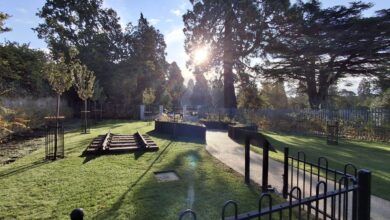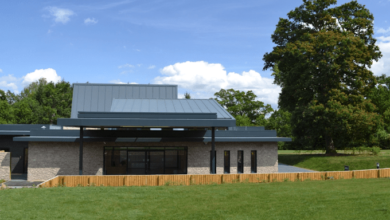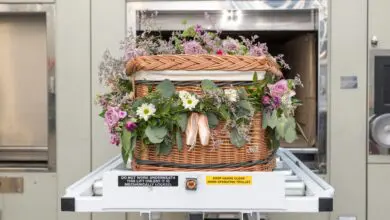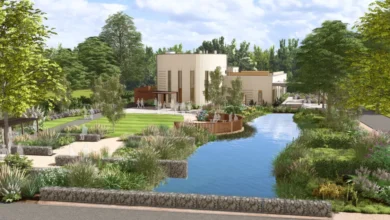Aquamation could be the path to other greener funeral practices
Alkaline hydrolysis will arrive in the UK 120 years after cremation, and with the practice known to use five times less energy than fire and reduce emissions by 35%, it will make us think about what else we could do to be green in death

Register to get 1 more free article
Reveal the article below by registering for our email newsletter.
Want unlimited access? View Plans
Already have an account? Sign in
As the first alternative to burial or cremation since the Cremation Act of 1902, alkaline hydrolysis – also known as aquamation – is due to be introduced in the UK by Co-op Funeralcare.
While providing people another option to consider for their funeral plan after more than 120 years is momentous, the UK will also be the first European country to officially introduce it. So far, it is only legal and accessible in Canada, only 30 of the US states, in South Africa, and could be made available in Ireland by the end of this year.
The process of alkaline hydrolysis sees that the deceased is enclosed in a biodegradable pouch, which is then placed in a container filled with pressurised water and a small amount of potassium hydroxide. The chemical along with the water then speeds up the natural process associated with burial.
According to UK-based firm Resomation, aquamation uses five times less energy than fire, and reduces a funeral home’s emissions of greenhouse gases by about 35%.
Each aquamation is said to take approximately four hours. At the end of the cycle, the soft bones, which are left dried, are then reduced to a white powder similar to ash. The remains are then returned to relatives in a sustainable urn.
Gill Stewart, MD of Co-op Funeralcare, says: “Up until now, choice has been limited to burial or cremation. We’ve seen from the rapid uptake of newer funeral options such as direct cremation, that when choice in the funeral market is broadened, this is only a positive thing both for the bereaved and for those planning ahead for their own farewell.”
According to research conducted by YouGov on behalf of the Co-op, alternative methods in end-of-life services – such as aquamation – have the potential to be a preferred choice for people in the UK; while 89% of adults in the UK hadn’t previously heard of the practice, once explained, 29% said they would choose it for their own funeral if it was available.
Furthermore, 17% of UK adults who have arranged a funeral in the last five years said they would have considered resomation for their loved one’s funeral had it been an option at the time.
Poppy Mardall, the founder and chair of London-based Poppy’s Funerals, says that her company has been asked about the availability of alkaline hydrolysis by clients.
“Some want the choice now, while others are enquiring about the future,” she says. “The question is often – ‘I’ve read about, I like the sound of it, when will it get here?’”
Mardall believes that the funeral industry needs to work harder to embrace all sustainable choices for our bodies when we die. Along with the strides the UK has made in finally making aquamation accessible, she believes there is more headway to be made in regards to respectful and thoughtful grave reuse. Mardall is also a “great supporter” of natural organic reduction – also known as human composting – in which the body turns itself into soil in 45 days without any interference.
She continues: “This could be a very good choice for people who like the idea of being buried locally and allowing the land to be managed to encourage native wildlife and fauna. Right now natural burial, which is an excellent choice, can be difficult for people who live in urban areas to access. I would like to see that service in the UK in the coming years.”
Like human composting, a technique of composting bodies with layers of organic material like leaves or wood chips, aquamation is still authorised only in certain countries. Up until 2019, it was thought that the disposal of waste water used in the process could be potentially dangerous, and therefore, should not be discharged into wastewater treatment works or sewer systems.
Mardall says: “There have been challenges with the water board – getting their agreement to accept the liquid that remains at the end of the process. This is a new choice, so of course, there are going to be challenges. The fact that our laws around death and funerals are so very old also has its challenges – on the plus side it means there is little law to stop people doing what they want to do, which is great.
“On the other hand, it means there is no one organisation to work with or campaign for in order to make a new choice possible, practical and legal.”
However, concerns around disposal of waste water from aquamation were put to bed when five UK water cremations, which were conducted in April 2019, were analysed against organic, inorganic and microbial parameters by Yorkshire Water. The results were assessed by experts at Middlesex University and showed that the funeral practice posed no concern for sewer systems and wastewater treatment works, nor their related operations and effect on water quality. Further still, the samples contained no traces of DNA.
Lian Lundy, professor of environmental science at the Urban Pollution Research Centre, Middlesex University, says: “For the first time, we had robust comparable scientific data on water cremation using standard sampling procedures and analytical methods.
“The results from the samples indicated that there is no technical reason why the liquid from water cremation cannot be discharged to the sewer for processing by standard water treatment methods.”
As a result, Resomation Limited achieved the UK’s first ‘wastewater consent to discharge’ later that year from Yorkshire Water, paving the way for water cremation consent applications from across the country.
In speculating the potential popularity of this funeral method, we should draw parallels between cremation and aquamation. Mardall pointed out that the legalisation of cremation in 1902, although “practised by our ancestors”, followed decades of activism and took further decades to become normalised. Only about 812 people (0.15% of deaths) were cremated in 1910, which grew to 82,000 (16% of deaths) in 1950, and now, roughly 500,000 (78% of deaths) in 2021.
“It’s very hard to project into the future to know what will happen. Based on history, we know it can take a very long time for any new funeral choice to become popular,” Mardall says. “But at the same time, the climate crisis is driving people to make more responsible decisions about how they live and die.”
She adds: “The last crucial piece of the puzzle is the absence of objective data to compare the impact of funeral choices; we still don’t fully understand the comparative impact on the planet of cremation, burial and new choices like alkaline hydrolysis.”
The arrival of alkaline hydrolysis in the UK is a sign that sustainability in death is not just a fad. As Mardall put it, “clearly, there are many simple things we can do to lessen our impact”, such as using native flowers at memorials, consider electric vehicles, avoid embalming where possible, and really think about the materials we buy – a locally grown willow coffin over MDF.
“The best thing we can do, both those of us who work in the sector and also the public, is to educate ourselves about our choices,” Mardall concludes. “I’d like to see the funeral sector doing more to signpost their clients to greener choices.”







